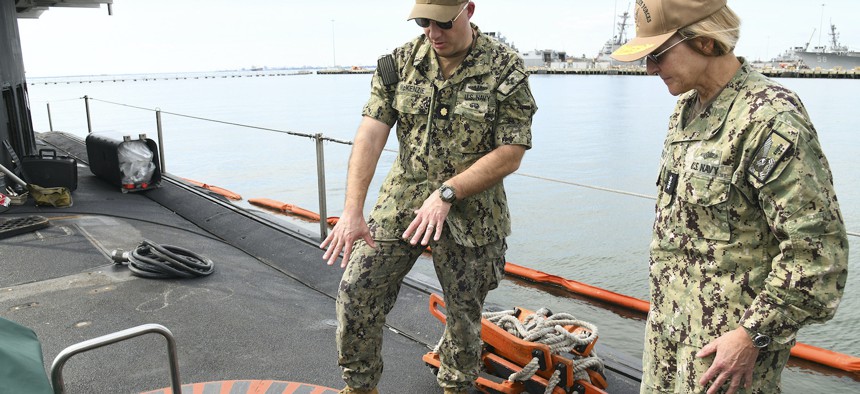
Lt. Cmdr. Douglas McKenzie, executive officer of the USS New Mexico, gives Vice Adm. Kelly Aeschbach, Commander, Naval Information Forces a tour of the submarine. U.S. Navy / Robert Fluegel
How The Navy Trains Its Info Warfare Officers Needs Work
The goal is to expand the training into virtual and synthetic environments in the next few years.
SAN DIEGO—Training the Navy’s information warfare operators isn’t easy, and technical and security challenges prevent operators from virtually learning the systems they’d use in a fight, officials said.
“We are not at our best in the training we're providing for our information warriors,” said Vice Adm. Kelly Aeschbach, the commander of Naval Information Forces, during a presentation at the WEST 2023 conference.
“We have a lot of good stuff in place, but we do not move fast enough, nearly fast enough, to pace all the capability we're delivering. Our brick and mortar construct has a lot of trouble keeping up with the agility with which industry and others now are delivering fantastic capabilities.”
Raising the caliber of the information warfare training delivered afloat is a top priority for Aeschbach. She argued that spending more money on the Navy’s Live, Virtual, and Constructive, or LVC, training program, which is used across multiple disciplines, would be equivalent to a direct investment into information warfare, because it’s “one area where you generally cannot really train to the capability you think is going to keep you in competition or is gonna give you an edge if conflict erupts.”
“We guess on a lot of that right now, and that's not a good thing,” she said. “We might be right; we might actually be underestimating how powerful our effects could be. But my guess is in some areas, we're probably wrong. And we have more work to do to ensure that the capability is most effective, or that the technique or tactic we've developed is the right one for employment of the capability.”
Last year, the command did several pilots that focused on connecting existing information warfare systems into the LVC environment, such as ships’ signals exploitation equipment and electronic warfare systems. Aeschbach said it has been hard to connect some of the systems to the training platform, and that it’s challenging to adequately replicate systems so sailors can train on technologies they would actually use in the field.
“Some of that is straightforward, and some of that turns out to be challenging for the engineers. And so we actually found that we needed to afford a little more time between pilots and what we were learning. And so we have a less aggressive schedule this coming year, which affords more time for the feedback loop on how they take on some of the engineering stuff, knock it down, and then we move into the next pilot,” Aeschbach told reporters.
“We eventually want to test that we can run all this out to a ship. And we do Live Virtual Constructive right now with our ships, but we do it at the secret level. And we don't really have much representation in terms of information warfare capabilities,” Aeschbach said, noting that the service has made progress toward connecting highly classified information to LVC.
To complicate things, many of the systems IW operators rely on are considered sensitive and need to be protected, so “it's very difficult for us to go and use them in the manner in which we would intend to do so in a fight,” Capt. Bryan Braswell, commander of the Naval Information Warfighting Development Center, told Defense One.
“The folks who don't get the benefit of the training in that kind of construct are those who sit at the keyboard or at the console of the system or capability,” he said.
The goal is to develop a closed network for training so IW operators can take advantage of virtual aspects.
“If we can take that system or capability and network it into a closed network, virtual and constructive environment, then that young [cryptologic technician or information technician] is able to then push their buttons and use their system inside that closed network,” Braswell said.
Adding IW to synthetic training that’s already happening in the fleet has its own challenges, particularly when trying to secure authorities for multiple security classification levels.
“The other thing is the Navy has fleet synthetic training that we do now. And so we're trying to integrate, I would say, multi-level classification into LVC, which is sort of where my focus of effort is: bringing those sort of higher-order systems into that multi-level security environment,” Braswell said. “And that's what makes it difficult. Multi-level security networks are always just difficult to construct with the right authorities, permissions, controls, etc.”
The goal is to have the problem resolved by fiscal year 2026, he said. But in the meantime, operators get limited training opportunities and other members of the fleet don’t see how information warfare works with other domains.
“We're kind of limited to classroom training versus live at-their-console-system training,” he said. “We have to fully integrate IW. The other warfare domains and areas and folks who work in those need to see us, need to see what we're doing and how we're doing it to fully integrate that across the entirety and the domains in the fleet.”
